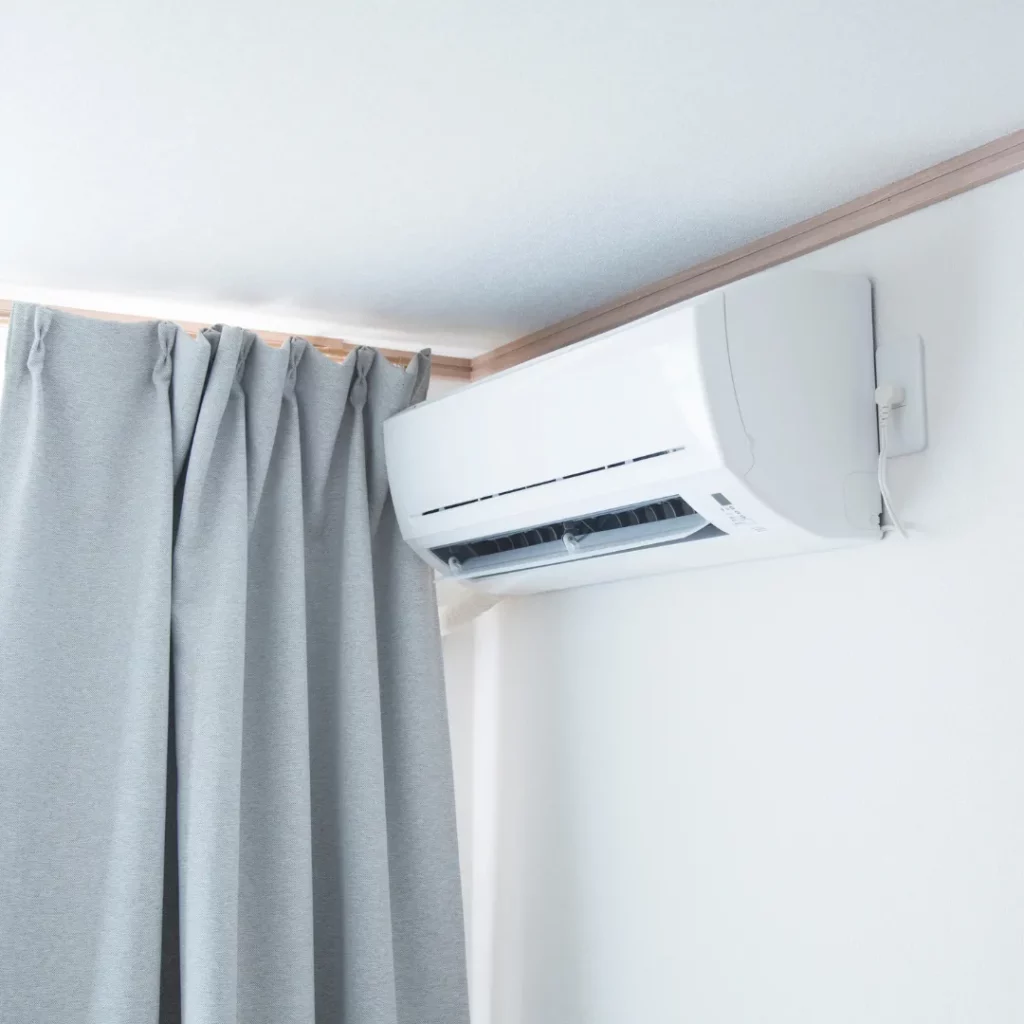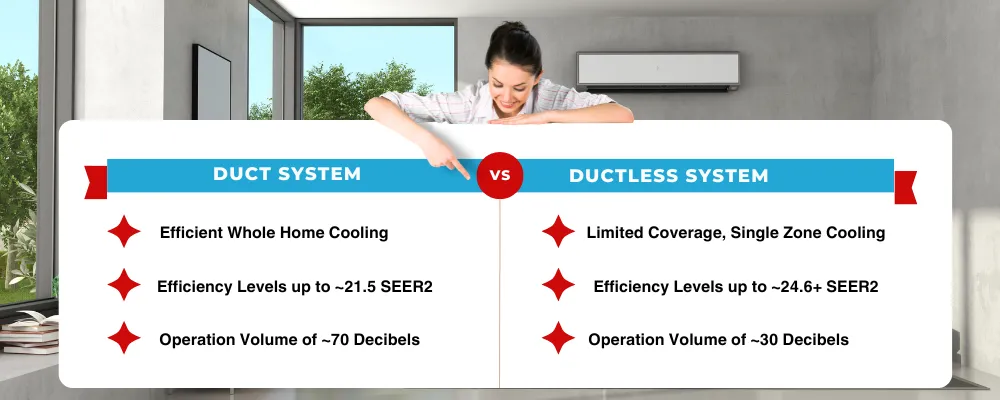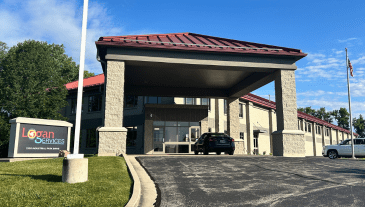When it comes to cooling and heating your home, several options are available, but one of the most popular choices is air conditioning (AC). However, there are two main types of AC systems to consider: ducted and ductless. Each has its advantages and disadvantages, and choosing the right one for your home can be daunting. In this article, we’ll help you explore the basics of duct and ductless AC systems, their pros and cons, and factors to consider to help you make the right decision.
Duct AC Systems
Duct AC systems, also known as central air conditioning systems or forced air systems, use a network of ducts to distribute conditioned air throughout the building. The ducts are usually made of sheet metal or flexible tubing and are installed within walls, floors, and ceilings. The air handler circulates the conditioned air through the ducts, which branch out to individual rooms or zones.
Advantages of Duct AC Systems
Ducted air conditioning systems offer a range of benefits, including efficient cooling and heating, centralized control, and consistent temperature distribution. Let’s explore these advantages in more detail.
Efficient Cooling and Heating
Because duct AC systems can simultaneously cool multiple rooms and transfer heat between different parts of the building, they can be more energy-efficient and cost-effective upfront than having several individual AC units.
Centralized Control and Consistent Temperature Distribution
A central thermostat controls the temperature for the entire building in a duct AC system, ensuring consistent temperature distribution in all areas. This offers a comfortable climate throughout the building, without the need for manual adjustment in individual rooms.

Disadvantages of Duct AC Systems
While duct AC systems provide several benefits, they also have some disadvantages, such as high initial installation and maintenance costs, and the potential for uneven temperature distribution and duct leakage. Let’s delve into these drawbacks.
High Initial Installation and Maintenance Costs
Installing a duct AC system can be more expensive than installing multiple individual AC units, especially in structures without existing ductwork. Maintenance costs can also be higher, as all ductwork components should be regularly cleaned and inspected to ensure optimal performance.
Potential for Uneven Temperature Distribution and Duct Leakage
Poorly designed or installed ductwork can result in uneven cooling and heating, leaving some parts of the building too warm or too chilly. Duct leakage, caused by gaps, holes, or disconnected ducts, can lead to energy loss and reduced system efficiency.

Ductless AC Systems
Ductless air conditioning systems, also known as mini-split systems, are becoming increasingly popular due to their flexibility, energy efficiency, and non-invasive installation process. These systems consist of an outdoor unit and one or more indoor units connected through a refrigerant line, eliminating the need for ductwork.
Advantages of Ductless AC Systems
There are several benefits to installing a ductless AC system in your home, which can make it an attractive option for homeowners looking for a more efficient and versatile cooling solution.
Easy Installation and Maintenance
One of the main advantages of ductless AC systems is their clean installation process. Since these systems don’t require any ductwork, they can be installed much more quickly and with less disruption to your home. Additionally, maintenance for ductless systems is needed less frequently and therefore less expensive, as there’s no need to clean or repair ducts.

Energy Efficiency and Cost Savings
Ductless AC systems are known for their impressive energy efficiency, which can result in significant savings on your energy bills. Traditional duct systems can lose up to 30% of their cooling and heating energy through leaks and conduction, while ductless systems effectively deliver almost all of their energy directly to the space they’re cooling.
Zoned Temperature Control
Another key advantage of ductless AC systems is their ability to provide zoned temperature control. Each indoor unit can be controlled individually, allowing you to set different temperatures for different rooms or areas within your home.
Disadvantages of Ductless AC Systems
While there are many advantages to these systems, there are also some drawbacks to consider when evaluating whether ductless AC is right for your home.
Limited Coverage Area
Ductless AC systems may not be ideal for larger homes or those with complex layouts. Since the cooling capacity of a single indoor unit is limited, you may need multiple indoor units to effectively cool a larger space, which can lead to higher upfront costs and increased energy usage.
How to Choose Between Duct and Ductless AC Systems

Deciding between a ducted and ductless AC system can be challenging, as each has its pros and cons. To determine the best option for your home, it’s essential to consider factors such as your home’s cooling and heating needs, cost and energy efficiency, and aesthetic preferences.
Assessing Your Home’s Cooling and Heating Needs
One of the first steps in deciding between a ducted and ductless AC system is to assess your home’s specific cooling and heating needs. Consider factors such as your home’s size, layout, insulation, and the needs of individual rooms. Ductless AC systems may be ideal for homes with smaller or open floor plans, while larger, more complicated homes may benefit more from traditional ducted packaged central air conditioner.
Cost and Energy Efficiency Considerations
When comparing the costs of a ducted versus a ductless AC system, analyze both the upfront costs and the ongoing energy expenses. While ductless systems can be more expensive upfront, their increased energy efficiency may help offset these costs over time. Assess how each system’s energy consumption aligns with your budget and sustainability goals to make an informed decision.
Making the Right Decision for Your Home
Ultimately, the decision between a ducted and ductless AC system will come down to your unique needs, preferences, and budget. In Ohio, it’s not uncommon for homes to utilize both ducted and ductless systems, so considered the added benefits that these combination of cooling systems can yield. Consult with an HVAC professional to discuss your options and gain expert recommendations tailored to your specific requirements.
Choose Logan Services A/C, Heat & Plumbing:
Logan Services A/C, Heat & Plumbing is a family-owned HVAC company in Dayton, Ohio. We offer a wide range of services, including installation, repair, and maintenance. We are committed to providing our customers with the best possible service and offer a 100% satisfaction guarantee. Contact us today to schedule a free consultation.
Here are some of the things that make us different from other HVAC companies:
- Family-owned and operated
- Wide range of services
- High quality parts and equipment
- Fully licensed and insured
- Variety of financing options
We are confident that we can provide you with the best possible service. Contact us today to learn more.
FAQs on Ducted and Ductless HVAC
What are the differences between ducted and ductless HVAC systems?
In basic terms, a ducted HVAC system utilizes a series of ducts to distribute conditioned air throughout your home or building, while a ductless system delivers air directly to a specific area without the need for ductwork. Ducted systems are ideal for homes with ample space, while ductless systems are perfect for configurations where installing ducts is not feasible or efficient. In a nutshell, both types are efficient in their own way, and the choice between them depends on the specific needs of the space being conditioned.
Can I switch from a ducted system to a ductless system or vice versa?
Yes, you can switch from a ducted system to a ductless system or vice versa. However, switching from one system to another can be complex and potentially costly. Depending on the existing setup and building structure, it might be easier to retrofit a ductless system in an older home that lacks ductwork or upgrade to a ducted system in a larger building with ample space for the necessary infrastructure. Always consult with an HVAC professional before making any decisions to ensure that you’re making the best choice for your specific situation.





















